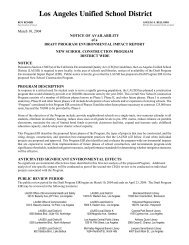Site-Specific Health and Safety Plan (HASP) - Laschools.org
Site-Specific Health and Safety Plan (HASP) - Laschools.org
Site-Specific Health and Safety Plan (HASP) - Laschools.org
Create successful ePaper yourself
Turn your PDF publications into a flip-book with our unique Google optimized e-Paper software.
LAUSD Proposed South Region High School #9 & Middle School #4<br />
6-14<br />
December 2006<br />
<strong>Site</strong> <strong>Specific</strong> <strong>Health</strong> & <strong>Safety</strong> <strong>Plan</strong> (<strong>HASP</strong>)<br />
clouds that are thick enough to produce a shadow (100 percent sunshine - no cloud cover <strong>and</strong> a<br />
sharp, distinct shadow; 0 percent sunshine = no shadows).<br />
c A normal work ensemble consists of cotton coveralls or other cotton clothing with long sleeves<br />
<strong>and</strong> trousers.<br />
d Saranex ® , Poly-Coated Tyvek ® , etc<br />
6.3.2.10 Urban Violence <strong>and</strong> Stray Animals<br />
All contact with transient population, hostile persons, or stray animals will be avoided. If<br />
potentially violent situation arises, project personnel will immediately remove themselves from<br />
the situation <strong>and</strong> contact the police <strong>and</strong> the PM.<br />
All site work will be conducted during the day (during day light, prior to sunset). No one will be<br />
allowed to work alone. The buddy system will be utilized at all times.<br />
6.3 BIOLOGICAL HAZARDS<br />
Various biological hazards may be encountered at the <strong>Site</strong>. These hazards include insects,<br />
spiders, toxic mold, harmful plants, <strong>and</strong> pathogenic <strong>org</strong>anisms or diseases such as hantavirus.<br />
Due to the location of the site (presence of homeless/transients), there also is a potential of<br />
encountering hypodermic needles <strong>and</strong> human wastes. Project personnel will avoid contact with<br />
these biological hazards. Sturdy work clothes <strong>and</strong> steel-toe safety shoes/boots will be worn by<br />
field personnel to defend against unanticipated biological hazards.<br />
6.3.3.1 Insect/Arachnid Bites <strong>and</strong> Stings<br />
Poisonous insects <strong>and</strong> insect-like creatures at the site may include red fire ants, bees (honeybees,<br />
bumble bees, wasps, <strong>and</strong> hornets), mosquitos, <strong>and</strong> spiders.<br />
Red fire ants may be observed, especially in the vicinity of existing monitoring wells. Do not<br />
st<strong>and</strong> on, place equipment on, or otherwise disturb the anthills. It is also advisable to place a<br />
four-foot square piece of plywood where personnel need to st<strong>and</strong>. An insect repellent may be<br />
used if it does not interfere with the desired sampling analyses. Tyvek ® suits can be worn or<br />
latex booties can be taped at the top to the pants of field personnel. Frequent self-checks for<br />
crawling ants should also be performed.<br />
Mild insect stings <strong>and</strong> bites should be treated by applying a baking soda paste or ice wrapped in a<br />
wet cloth. Do not pull out stingers with tweezers or fingers. Stingers should be gently scraped<br />
from the skin, working from the side of the sting, using your fingernail, the edge of a credit card,<br />
a dull knife blade, or other straightedge object.<br />
Equine encephalitis, an inflammation of the brain, can be carried by mosquitoes. Symptoms<br />
range from none to mild flu-like symptoms (fever, headache, sore throat) to rare infection of the<br />
central nervous system with sudden fever <strong>and</strong> severe headaches followed quickly by seizures <strong>and</strong><br />
coma. In the more severe variety, the mortality rate is up to 60 percent, with permanent brain<br />
damage in many of the survivors. Field personnel must wear long-sleeved clothing <strong>and</strong>/or use a<br />
DEET (N,N-diethyl-meta-toluamide) containing insect repellent if they are working in areas of<br />
mosquito infestations.<br />
West Nile virus is spread by the bite of an infected mosquito, <strong>and</strong> can infect people, horses,<br />
many types of birds, <strong>and</strong> some other animals. Most people who become infected with West Nile<br />
virus will have either no symptoms or only mild ones. On rare occasions, West Nile virus<br />
infection can result in a severe <strong>and</strong> sometimes fatal illness known as West Nile encephalitis (an<br />
205







